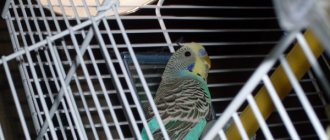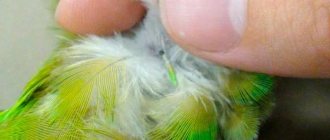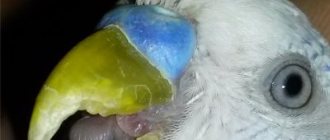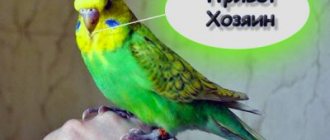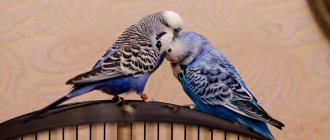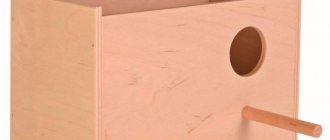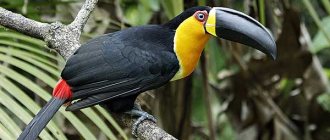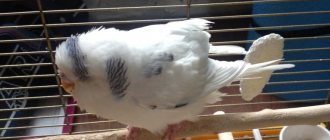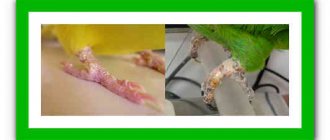The health of a budgie depends on the conditions under which it is kept. Often, failure to maintain hygiene of the cage, the pet itself, and improper nutrition can cause his illness and premature death. How to treat budgies when they are sick?
Birds, as a rule, have good immunity, but even healthy birds can be ruined if they are not kept in good faith.
What does a healthy wavy look like?
With good care, budgerigars can live on average 16-18 years. An indicator of its health is always how the bird looks. Healthy wavy feathers have a rich and bright color, and the plumage itself is shiny and glossy.
The parrot's eyes are wide open, and his gaze is expressive and curious.
In a normal state, your pet will be cheerful, happy to play in the crate, happy to interact with its owners and chirp happily.
Whether kept alone or in pairs, the parrot will carefully look after its feathers and clean them for itself and its friend.
However, there are not many long-livers among budgies, since often their owners do not worry too much about caring for their pet, as a result of which the feathered friend becomes lethargic and sad, and begins to get sick.
How to understand that a parrot is sick
A healthy parrot has clean, bright plumage, clear and expressive eyes, eats well and takes care of its appearance. He is interested in the world around him and reacts to everything that happens around him.
If a parrot is sick, then it looks lethargic and drooping, it is not interested in anything. The owner should be alert to the main signs of disease in his feathered friend:
Due to illness, the bird becomes lethargic.
- the bird moves little, does not fly and sleeps a lot;
- movement coordination is impaired;
- eats poorly or refuses food altogether;
- thirst increases;
- breathes heavily and sniffles;
- eyes squint or close frequently, discharge may appear from the eyes and beak;
- the plumage becomes dull and unkempt;
- growths may appear on the paws and beak;
- vomiting, constipation or liquid droppings.
Many diseases develop quickly; treatment started at the wrong time can lead to complications and even the death of your feathered friend.
Healthy or not?
If a bird starts to get sick, its appearance and behavior changes. The owner of the bird is trying to understand what exactly is tormenting the parrot. But sometimes the symptoms of different diseases are very similar, and the owner of the bird begins to treat the bird for a viral disease, while the wavy is attacked by parasites.
The following symptoms are typical for a sick parrot:
- Long sleep.
- Poor plumage appearance.
- Decreased activity.
- Sniffling and heavy breathing.
- Frequent sneezing with mucus discharge from the nose.
- Constant thirst.
- Inflammation of the joints and the appearance of growths on the paws.
- Prolonged diarrhea.
Viral diseases of parrots
It is these diseases that pose the greatest threat to poultry health.
As in the human body, viruses in the parrot's body spread very quickly and even mutate.
This greatly complicates the treatment process and diagnosis.
And only well-known medicines called antibiotics can help.
Bird flu
The name of this disease is widely known to us from the media.
And, sad as it is, it affects not only chickens and geese, but also parrots. This virus is extremely dangerous and poses a great threat to the life of a parrot.
Its strain is also well known to us - H5N1. Light contact with a carrier of the virus is enough for it to enter your pet’s body. The symptoms of bird flu are very similar to human flu.
Like all of us, a sick parrot practically stops eating, becomes lethargic, and sometimes begins to lose feathers.
It is almost impossible to cure bird flu; we can only advise you not to allow your parrot to come into contact with outside birds. This is the only way to prevent the disease.
Smallpox
An extremely dangerous disease, scientifically known as Borreliota avium. Unfortunately, medicine cannot defeat this virus, and therefore an infected bird is doomed.
As in the case of bird flu, a sick parrot suddenly loses its appetite and all interest in the world around it.
You should also immediately look at his tongue, and if you notice a white coating, then this is a reason to immediately sound the alarm.
Further changes in the appearance and body of the parrot are already irreversible, and for loving owners they are a real nightmare.
The parrot begins to have diarrhea, sometimes with the appearance of blood, vomiting constantly, and terrible-looking abscesses form on the head.
The bird begins to constantly experience dehydration, loses the ability to move and dies.
So, the worst part of our article is already behind us. Now we will talk about diseases that are quite treatable.
They are caused by nothing other than bacteria that surround us everywhere.
Signs of illness in a parrot
If you feel unwell, your feathered friend literally tries to talk about his health problems with his appearance.
You should be wary if:
- Wavy sleeps most of the time, and when you try to play with him, he crows and falls back into sleep.
- A protruding keel may indicate severe malnutrition, which needs to be treated urgently, preferably under the supervision of an experienced ornithologist veterinarian.
- The parrot's breathing is difficult: he sniffs or breathes heavily. These symptoms may indicate problems in the lungs and the bird needs urgent treatment.
- If your parrot drinks too much water, then it probably has problems with the gastrointestinal tract. Often this symptom is accompanied by diarrhea, so diagnosis and treatment are necessary.
- A bird in a sitting position points its tail perpendicular to the floor. This is a sign of possible lung disease. Do not try to carry out treatment at home, this will only harm your pet.
- There are growths on the parrot's paws and inflammation of the joints, wounds and skin irritations are visible to the naked eye. Such diseases and their treatment should be under the supervision of an experienced doctor to prevent the death of your feathered friend.
Disease categories:
- parasitic diseases;
- infectious diseases;
- diseases caused by violation of feeding and maintenance rules.
How to cure a parrot
If your pet develops a disease, a specialist can tell you how to properly treat the parrot. First, he will conduct the necessary examination, and after that he will be able to select the correct and effective treatment therapy. He will tell you what to do if your parrot gets sick.
Veterinary clinics
Treatment of parrots in a clinic is carried out under the supervision of a doctor. Usually he prescribes drugs and antibiotics that can suppress the development and eliminate the disease. Types of medications depend on the disease:
- For infectious pathologies, special antibiotics are prescribed for budgies. It is also recommended to use medications with anti-inflammatory and restorative effects;
- In case of poisoning, adsorbents and enzyme preparations are used - Smecta, Enterosgel;
- Vetom and Linex are used to normalize digestion;
- If the bird has internal bleeding and black droppings, then treatment is performed using Dicin;
- If the bird has ectoparasites, then the following external agents can be used - Aversectin ointment, Insektol, Celandine spray, Frontline.
Self-medication
Many owners of feathered pets are often interested in how and how to treat a parrot at home? Treatment can be carried out at home only in cases where the disease has just begun and is not serious. But in case of complications, it is better to consult a doctor.
Measures you can take at home:
- Improve nutrition;
- Ensure regular cleaning of the cage;
- Vitamins should be included in the diet;
- Carefully monitor poultry hygiene;
- From time to time, the parrot should be released from the cage so that it can fly.
If your pet has a cold, it is recommended to warm it up over a table lamp. He also needs to be given chamomile decoctions, teas with lemon and honey. Inhalations based on eucalyptus and menthol have a good effect. If the bird has wounds or ulcers, they can be treated with iodine or brilliant green. Potent drugs should be given under the supervision of a veterinarian.
We recommend reading: How to breed budgies at home
What are the symptoms of budgerigar disease?
A healthy bird is easy to identify. As a rule, she is active, sociable and has a good appetite. Budgerigars come to the feeder and drinker 3-4 times a day, thus providing themselves with the necessary energy.
They happily communicate with their owner, fly around the room and chirp happily. Any other deviations from usual behavior should alert a loving owner, since the symptoms of the disease in a parrot of any breed are similar.
Litter
One of the first signs of disease that worries a poultry farmer is droppings.
It may change color as a result of changing food, but be sure to consult a doctor if your feces exhibit any of the following:
- liquid consistency;
- droppings are too dense;
- bright, rich color - yellow or orange;
- rusty, brown or black inclusions.
All these symptoms indicate poisoning, bacterial infection or damage to internal organs.
Treatment in this case is necessary, since with diarrhea the bird very quickly dies from dehydration.
Feathers
Plumage should also be cause for concern. A healthy bird always has smooth and shiny feathers.
What symptoms should a breeder be concerned about?
- If the parrot clucks often. With such habits, parrots can hide significant weight loss. If this occurs for more than a day, immediately consult a doctor for treatment!
- Dirty cover. Budgerigars are very clean and constantly clean their feathers. Therefore, if he looks unkempt, and the feathers on his tail and wings are frayed, then your bird is probably sick and needs help.
- Feathers stained with droppings can be a symptom of bacterial infections. Their treatment is extremely difficult, and if you miss the moment, you may lose your friend.
- Molting in birds. This is normal, but if the loss of feathers is accompanied by complete exposure of the body, they need to be treated. These can be external parasites: ticks, feather eaters or fleas.
Voskovica
Experienced budgerigar breeders know that the wax always indicates problems with the bird’s well-being.
Symptoms of the disease that you should pay attention to are the following:
- redness or darkening;
- inflammation;
- mucus discharge from the cere;
- peeling.
In general, if the cere suddenly changes color or structure, or atypical formations appear on it, then this is a reason to visit an ornithologist veterinarian.
This may be signs of a lack of vitamins or hormonal imbalances, or it may be a sign of the presence of mites or fungus. In this case, the bird needs high-quality treatment under the supervision of a doctor.
Eyes
Healthy parrots have a piercing and inquisitive gaze. Any clouding of the wavy's eyes, mucus secretion, or rolling up of the cornea are bad signs.
If you have these problems, you should immediately consult a doctor. Treating them at home without proper attention can lead to the death of the parrot.
Eye diseases are very dangerous for birds. It can be:
- vitamin deficiency;
- conjunctivitis;
- eye injuries;
- bacterial or fungal infection;
- cold;
- viruses.
In order to cure them, it is necessary to resort to serious methods. And to avoid eye disease in your parrot, protect it from drafts, hypothermia, dust and smoke, and also keep the cage clean.
Appetite
Parrots have an enviable metabolism, which is why they often love to feed on the feeder. They follow the principle of fractional meals - several times a day in small quantities. That is why they remain in excellent physical shape throughout their lives.
If your bird suddenly loses its appetite and does not come to the feeder every day, this may indicate illness.
Symptoms such as intestinal colic, constipation, diarrhea can characterize enteritis and poisoning.
Another bad symptom may be vomiting.
It is dangerous not only in itself, but also as a symptom - the bird can suffocate in the vomit and die.
If your parrot has diarrhea and drinks very little water, you should consult a doctor, otherwise the bird may die from dehydration.
Breath
In a healthy wavy, breathing should be calm and even. If a parrot is breathing with its beak open, this is a sign of illness. Unfortunately, these southern chirpers often have respiratory problems.
If your parrot breathes with its beak open while sitting and raises its tail parallel to the floor, then it is seriously ill.
Only a veterinarian should make a diagnosis and prescribe their treatment, but as a rule, this is impossible at home and hospitalization will be indicated.
Other signs of respiratory diseases:
- cough;
- runny nose;
- sneezing.
These symptoms may indicate that the bird has a cold or allergies. Unfortunately, many breeders do not realize the dangers of smoking for themselves and poison others, including their pets, with smoke.
Mood
As a rule, budgies love active pastime and sing songs without any embarrassment. This is a sign of good spirits.
If a bird has stopped chirping and has been in a depressed mood for a long time, you should pay attention to its health.
Diseases associated with low mood and depression can be caused by viruses and infections; they are easier to prevent than to treat.
The following may be alarming symptoms in the behavior of a feathered friend:
- A budgerigar hides its head under its wing and dozes all day.
- During sleep, the bird sits on two legs.
- The parrot sits at the bottom of the cage.
The last sign is especially dangerous - the bird cannot climb onto the perch, which indicates severe weakening.
Limbs and joints
Any deviations from the normal state in the birds' legs and joints are a sign of infection or parasites.
Show it to an experienced ornithologist who can make a diagnosis and prescribe treatment.
Causes of diseases
The causes of bird disease are in most cases associated with the following phenomena:
- non-compliance with feeding regimen;
- improper care;
- violation of conditions of detention;
- untimely cleaning of the cage;
- drafts and dampness;
- hypothermia or sudden temperature changes.
Also, infectious diseases can arise from food. Their source may be other birds living in the wild, or new parrots that have been caged without quarantine.
If you find any signs of illness, then it is necessary to isolate it from other poultry and provide quality treatment.
To keep your chirper healthy and happy, a balanced diet and good hygiene are essential. Do not forget that we are responsible for our pets, and so that treatment does not darken your days, be attentive to the symptoms described above.
Cold
Budgerigars are very sensitive to sudden changes in temperature, which is why any draft can trigger the onset of illness. As a preventive measure, carefully monitor the windows and vents; they must be closed.
If the parrot is sick, then the first aid will be a lamp that will warm the bird, inhalations with tea tree oils and a chamomile decoction added to the drinking bowl.
Remember that you should treat a bird only after visiting a doctor; very often it turns out that the parrot did not have a cold, but another infection, or that parasites have settled in its body, causing similar symptoms. Heating and inhalation will help alleviate the bird’s condition before visiting a doctor, but in no case will they become a panacea.
Common diseases
If your parrot suddenly gets sick, you should be wary. Some diseases can go away on their own, but most can become severe and cause complications. Therefore, the owner must have an idea of what diseases can occur in birds and how to treat budgies.
We recommend reading: What fruits and vegetables can be given to budgies
Cold
It is important to remember that budgies have increased sensitivity to sudden changes in temperature, so even a draft can cause the development of a cold. For this reason, carefully monitor the vents and windows; they must be closed.
How can you determine that a parrot is sick? It is worth carefully examining his appearance; he will look unhealthy and inactive. The bird may sit in one place for a long time, and mucus may be released from its eyes and nose.
If your budgie has a cold, it will exhibit the following symptoms:
- Lethargy;
- Apathy;
- He may sneeze;
- Poor appetite;
- He sleeps constantly;
- The plumage becomes ruffled.
Before starting treatment, the bird must be taken to see a veterinarian. The specialist will conduct the necessary examination and determine the presence of a cold. Based on the data obtained, he will be able to select the appropriate treatment therapy.
At home, you can warm up your feathered pet using a lamp. Additionally, you can perform inhalations using tea tree oil. To improve the condition and speed up recovery, you can add chamomile decoction to the drinking bowl.
Ticks
When studying diseases of parrots, it is worth paying attention to ticks. Parasites often affect birds, they can come from anywhere - from other pets, the owner can bring them on clothes from the street.
When they appear, the bird begins to constantly itch. She experiences severe itching, which bothers her and causes discomfort. When these manifestations appear, it is worth moving the plumage apart; ticks can be found between the feathers. They can also be observed on the paws, near the eyes and beak.
It is important to remember that mites cause serious harm to the health of birds; they can cause the formation of growths on the surface of the paws or beak. Vaseline or vegetable oil works well; it will block the air and the pests will not be able to breathe, as a result they will die. For treatments, you can use aversectin or novertin ointment.
Goiter inflammation
Every owner of feathered pets should remember that many diseases of budgies can occur without any symptoms, so they can be ignored. Goiter inflammation is one of them. This pathological process cannot be detected at the initial stage, so it often develops into a complicated form.
The following factors may cause:
- Various toxic substances that birds can inhale;
- Consumption of low quality feed mixtures;
- Deficiency of useful elements;
- Using dirty water;
- Various complications after infectious diseases.
It is important to first study the symptoms and treatment features of budgerigar disease. Usually, when the goiter is inflamed, the bird does not eat food, it is lethargic, and practically does not drink. Over time, she begins to vomit, which may contain mucus.
Poisoning
Poisoning is a common ailment of birds. They can occur when consuming low-quality feed mixtures and unpurified water. These diseases in budgies can occur due to improper nutrition.
How can you tell if your parrot is sick? The main symptoms of poisoning include:
- The appearance of liquid droppings;
- Severe lethargy;
- Frequent vomiting;
- Poor appetite;
- Drowsiness.
In case of poisoning, the parrot should be given an absorbent. Smecta and Polysorb have a good effect. They are infused into the bird using a syringe. Dairy-free cereals are suitable for feeding. Additionally, it is worth warming your pet; a table lamp is suitable for this.
Paw injuries
Diseases of parrots can be associated with paws, namely with injuries to the limbs. They may experience dislocations, fractures, bruises, and sprains.
If a sick parrot experiences a deterioration in its condition, it is definitely worth taking it to see a veterinarian. He needs to be taken to a specialist urgently if the damaged paw is immobilized, red and swollen. The hospital will perform the necessary examination and select the appropriate treatment.
Vomiting, diarrhea and constipation
The occurrence of vomiting, diarrhea or constipation often occurs in a budgerigar with a poisonous disease. When poisoned, the bird begins to burp frequently after eating food. This may result from the following:
- When overfeeding birds;
- Insufficient supply of useful elements;
- Wrong diet;
- Liver problems;
- Peritonitis;
- Presence of parasitic organisms;
- Toxin poisoning.
Many infections in budgies are accompanied by vomiting and diarrhea. All this quickly leads to dehydration of the bird and subsequent death. In these cases, you should immediately contact a veterinarian; he will be able to save your feathered pet and prescribe effective treatment.
Lipoma
A lipoma is a tumor formation on the abdomen of a bird. It is located in the lower part of the abdomen, but can sometimes occur on other parts of the body. The tumor is benign. You may feel a ball moving under your skin.
If a budgie gets sick with this pathological process, then many owners may have a question - what to do in this situation? How can I help him? You can’t do anything on your own, otherwise you could harm your pet. It is important to visit a veterinarian immediately.
Treatment of this disease in budgies is accompanied by a special diet that is aimed at reducing weight. Lipoma is caused by obesity. The menu should include more cereals, vegetables and herbs. Also, periodically, the pet should be allowed out of the cage to fly.
We recommend reading: Choosing and arranging a cage for a budgie
Inflammation of the cloaca
When studying what ailments parrots have, it is worth paying attention to inflammation of the cloaca. This disease develops as a result of poor nutrition, lack of vitamins, and also when the bird eats difficult-to-digest food. Inflammation can develop due to poor quality cleaning of the feathered pet’s cage.
The following symptoms of the disease are observed in a budgerigar:
- Diarrhea;
- Gluing and clumping of feathers around the cloaca;
- Inflammation of the skin near the cloaca, signs of swelling;
- Significant weight loss;
- Lack of appetite;
- Decreased activity;
- The appearance of blood and mucous discharge.
If symptoms occur, you should contact your veterinarian. Only a doctor can conduct a quality examination and prescribe the necessary examination.
Food poisoning
Due to the low quality of products, and sometimes the desire to save money and buy cheaper food, our wavy neighbors have to suffer. Almost every bird experiences food poisoning. The reason could be improper nutrition, because some owners feed the bird food from the table. Spoiled vegetables and fruits can also cause poisoning.
Symptoms of poisoning are: liquid droppings, vomiting, lack of appetite and drowsiness. If you are sure that the bird independently stole something “forbidden” from the table, give an absorbent. You should not use activated carbon; it absorbs not only harmful, but also beneficial substances.
“Smecta” or “Polysorb” are suitable, they are diluted in water and poured into the parrot’s beak using a syringe without a needle. Eliminate vegetables, fruits and herbs from the diet; the bird should eat only high-quality grain feed; “Vaka” or “Chika” are not suitable for this purpose.
If your budgerigar refuses to eat, you should force-feed baby dairy-free cereals every 2-3 hours. Heating will not interfere with the bird; a table lamp with a power of up to sixty watts will do. Even if you are completely sure that it is poisoning, it is strongly recommended to do tests in order to exclude other diseases with similar symptoms.
Parasitic diseases
Everyone knows who parasites are.
Sad statistics from ornithologist doctors indicate that 25% of all wavy birds who come to see a doctor are sick with ticks and other parasites. The cause of infection with this unpleasant disease may be contact with another bird, or with an infected object.
To prevent infection by ticks, you should adhere to veterinary and sanitary rules: do not use used cages and equipment for them.
Among the external parasites, wavy birds can be bothered by:
- down-eaters;
- ticks.
Parrots can become infected with external parasites in the summer, when they are taken out in cages onto the grass, which may contain ticks and feather-eaters. The former are located and parasitize on the skin and inside the lower part of the feather under the skin, as well as in the trachea. The latter live on the surface of the wavy’s body.
There are a large number of species of mites, and the consequences of their parasitism on the body of a bird are also very different.
You can identify one type of tick or another by the symptoms:
- the mite that lives in the lower part of the feathers makes them brittle and dull, as a result of which it is difficult for the parrot to fly;
- down-eaters cause severe skin itching in the parrot, which disrupts their normal rhythm of life;
- The tracheal mite can infect a parrot's lungs, causing coughing and sneezing. Shortness of breath and clicking sounds from the bird's beak are also possible.
Down feather eaters can be seen with the naked eye, and their eggs can be found from the inside of the wing.
They are visible on feathers of the third and fourth order, as well as on the grooves of these feathers. Mites parasitize on those parts of the parrots' body that are not covered with feathers. This is the skin in the eye area, beak, anus (cloaca), paws. Its appearance can be determined by growths that have a porous structure similar to pumice.
The functioning of the affected part of the body deteriorates: if the beak is infected, it is difficult for the parrot to eat, claws may fall out on its paws, and if the eyes are affected, there may be partial blindness.
It is impossible to treat parasitic diseases on your own, since drugs against external parasites are quite toxic and, if overdosed, can lead to the death of the feathered patient.
After examination, the doctor prescribes treatment, he also determines which microorganism is parasitizing on the bird’s body and selects one or another drug that will bring the maximum therapeutic effect.
Unfortunately, there are no special devices for prevention that are commercially available for cats and dogs. Therefore, the only way to prevent infection is to strengthen the immune system and maintain cell hygiene.
Tracheal mite (Sternostomosis)
When infected with tracheal mites, a budgie can often throw its head back, and breathing becomes labored and wheezing, and there is frequent coughing and regurgitation of food eaten.
Some of the mites remain in the trachea, and some pass into the lungs; their presence there irritates the mucous membrane and causes mucus secretion and increased coughing, due to which some of the parasites are released. If the disease is ignored, the budgie may die from suffocation.
Before treating infected birds, they should be placed in a separate “quarantine” cage. Treatment is carried out with Ivermectin, it destroys the nerve endings of the parasites, which leads to their death. Treatment is carried out over two weeks, since the drug acts only on mature individuals without destroying the eggs.
Permethrin can not only cure infected parrots, but is also good as a prophylactic agent.
Red bird mites
Red ticks are dangerous not only for birds, but also for humans. Ticks actively feed on the blood of the carrier, which ultimately leads to loss of strength and anemia in parrots.
The feathered skin becomes gray in color, and inflammatory processes often occur on the mucous membranes and muscles. If the parasite chooses a chick as a victim, then in most cases this ends in the death of the baby. Red ticks are afraid of daylight, so the active feeding phase occurs at night, and during the day the parasites hide in the cracks of the cage and other secluded places.
The drug Neostomazan, an ampoule of which is diluted in 400 ml, will help get rid of the disease. warm water. Then the cage, all the equipment in it, and the parrot itself are thoroughly treated with the resulting solution. Wavy should treat the skin around the eyes, cloaca, paws and beak. After 10 days, the procedure should be repeated to avoid relapse.
Scabies mite (Knemidocoptic mange)
Scabies mites infect the beak, wax and paws, causing damage.
At the same time, the bird suffers from constant itching. The affected skin scales rise and it becomes lumpy. The affected paws become inflamed and tissue necrosis begins, which leads to the appearance and increase of growths. The wavy begins to gnaw on the affected areas, constantly shifting from paw to paw, and sometimes pulls out feathers. When infected with ticks, a parrot is able to scratch the affected areas until they bleed.
If treatment is not started in time, the disease will result in irreversible deformation of the beak, loss of fingers or entire limbs.
However, the source of the disease can be eliminated with the help of Aversectin ointment. It is quite easy to find in veterinary pharmacies.
It is carefully applied to the areas affected by the tick once every 4-5 days until complete recovery. After killing the ticks as a preventive measure, repeat the procedure a couple more times. The ointment is quite safe, but if it gets into the bird's eyes, rinse them thoroughly with warm water.
Parasitic worms
Usually these “guests” enter the stomach of budgerigars through food. Birds swallow eggs, from which worms eventually emerge. These parasites most often live in the small intestine, sometimes entering the large intestine. An infected bird rapidly loses weight, becomes lethargic, and worms can be seen in the droppings.
For treatment, the drugs Phenothiazine and Piperazine are used, which can be combined with each other, based on the advice of the doctor who made the diagnosis. As a preventative measure, try to protect your parrot from contact with foreign birds, and when purchasing a new bird, do not forget to place it in a separate cage for a month’s quarantine.
Down-eaters
These insects quite often bother budgies living in enclosures.
Down feather eaters feed on feathers and skin flakes, while moving quite actively along the bird’s body and causing it discomfort. Infected parrots constantly scratch themselves, and when examining the bird, downy feather eaters are easy to spot; in appearance, they look like small dark dots about two millimeters in length.
Treatment is carried out with special sprays. Frontline is good for this purpose. However, only your doctor will tell you the frequency and dosage of use.
In addition to treating the bird with the drug, do not forget to thoroughly disinfect the cage. The spray can also be used for preventive purposes.
Internal parasites
Internal parasites include helminths and protozoan unicellular microorganisms. They become infected through poor quality food.
Symptoms of helminth infection are as follows:
- stomach upset;
- dyspnea;
- a sharp decrease in the weight of the bird;
- the wavy bird is often tufted.
Parasites such as roundworms attack the stomach and can cause the rapid death of the pet. There are no vaccines for this, but treatment needs to be started.
Coccidiosis
The causative agent of the disease is parasites that live on the walls of the intestines and kidneys of the budgie. Usually their victims are young individuals who are less than a year old. Moreover, parasites do not always manifest themselves, sometimes a bird is a carrier without getting sick itself, but in the end, when the body weakens a little, these single-celled organisms will make themselves felt.
The incubation period lasts about a week, after which the first signs of illness begin to appear. The budgie drinks more, but eats almost nothing, its feathers are ruffled, and there is rapid weight loss.
The bird's stool becomes liquid, sometimes mixed with blood, and the bird periodically vomits. If the cause is not found out in time, the budgerigar will die from general exhaustion and dehydration.
With high humidity, parasites form. Coccidia enter the parrot's body through contaminated food.
If the result is positive, treatment with eimeriostatics is necessary. These are antibiotics that suppress the vital functions of organisms. In addition to them, there are drugs that are given to birds as a prophylaxis in order to prevent the development of diseases in large concentrations of parrots.
When the disease affects a chick, the treatment will most likely be ineffective; the disease progresses so rapidly that the parrot burns out literally within a day, suffering from high fever and convulsions. Young parrots are not immune to coccidiosis.
PARROT DISEASES AND THEIR TREATMENTIn their homeland, budgerigars are perfectly adapted to their living conditions. Birds have a busy life; they simply have no time to get sick. Of course, bird epidemics do occur in Australia, but, as already mentioned, this does not happen often. However, in a climate that is foreign to budgies, they sometimes get sick, and the owners are most often to blame for this.
EVEN WITH CAREFUL CARE, A PARROT CAN GET ILL.
Neglect or improper diet can affect the bird's health. Therefore, when purchasing a parrot, you need to have an idea of the diseases to which feathered fidgets are susceptible, and what needs to be done if your pet gets sick. Veterinarians quite often have to deal with the problem of mites in parrots. Indeed, these unpleasant insects can affect not only cats and dogs, but also birds. If your pet is restless, often throws its head back, has difficulty breathing, coughing, if the bird regurgitates the food it eats, sneezes, it is possible that the parrot has become infected with a tracheal mite
.
Parrots living in enclosures sometimes become infected with down feather eaters.
These parasites are quite rare in birds living in individual cages.
Down-eaters feed on skin flakes and gnaw through the feathers of parrots. The parasites on the bird's body constantly change their location and thereby cause anxiety; the parrot constantly scratches itself. When examining a sick bird, down feather eaters
can be found on the surface of the parrot's body. To do this, you need to carefully examine all the plumage. The main sign of their presence is damaged feathers.
Red bird mite infestation
happens in the middle climatic zone of Russia quite often. These pests affect not only poultry, but also the inhabitants of forests and fields. Indoor parrots, unfortunately, also often become victims of this type of mite.
It is especially worth noting that red bird mites pose a danger not only to birds; they can also infect other pets, as well as humans.
The main sign that small parasites have settled on human skin is the appearance of a rash. The patient experiences itching and scratches constantly.
Infection of a bird with these mites becomes noticeable when it develops anemia due to constant loss of blood. The parrot becomes lethargic, weak, and has a very poor appetite. Most often, these mites infect parrots living in aviaries, but this often happens to birds that are kept separately. Ticks “attack” their prey at night; during the day they hide, hiding in the cracks of the cage. They can often be found in the nest box, sometimes even during daylight hours.
Most often, birds themselves destroy insect pests. For most birds, they form the basis of their diet.
To rid birds of ticks, veterinarians advise using insecticides.
These preparations must be used to treat the entire cage or aviary, as well as all objects inside the bird's house, including the nest box. You can buy insecticides at pet stores. When treating a cell with the drug, it is important to follow the dosage indicated in the instructions. An overdose can negatively affect the health of pets. IN ORDER TO DETECT THE DISEASE IN TIME, IT IS RECOMMENDED TO EXAMINATE YOUR BUDGET REGULARLY.
Often, budgerigars suffer from ringworm, scabies, and fungal diseases of the beak. All these diseases are transmitted by scabies mites
. One of the external signs is a “scaly face” - rough-scaly spots that are light gray in color. If you look closely, you can see many small, seemingly drilled holes. These spots in most cases appear in the area of the cere, eyelids, cloaca, growths on the beak, and on the legs.
The first sign of the presence of scabies mites are small holes in the area of the beak and cere. Most often, scabies mites affect young individuals.
Scabies mites are not easy to spot and can live on the surface of a parrot's body for years without causing serious illness. This is precisely what can explain why a bird, sitting in a separate cage for a long time, suddenly becomes ill for no apparent reason.
The rate of development of the disease depends on many factors - conditions of keeping birds, diet, infections, excessive loads, etc.
Scabies is usually transmitted from sick birds to healthy ones through mites. This disease is treated with dimethyl diphenylene disulfide; this drug can be purchased at a pet store or from a veterinarian. During the entire course of treatment, it is necessary to give the parrot vitamins dissolved in water.
Just like other birds, parrots can become infected with endoparasites.
.
This usually happens when the rules for keeping birds are not followed. If you keep your parakeets in separate cages, it is unlikely that they will become infected with these parasites. Infected birds do not die, since endoparasites themselves live only as long as their carrier is alive. SOMETIMES A SIGN OF DISEASE IS THE APPEARANCE OR BEHAVIOR OF THE PARROT
One of the types of endoparasites are parasitic worms
.
They mainly affect budgies, which are kept with other birds. Infection occurs when eggs of parasitic worms
. By swallowing food, the parrot also swallows the parasite. Mainly such worms affect the small intestine, but can also enter the large intestine, as well as into the crop of a bird. The infected parrot begins to lose weight and becomes apathetic. Parasites can be found in poultry droppings. Treatment for parasitic worms involves some difficulties. The medicine is injected directly into the parrot's crop, this is done using a special button-shaped probe. During such procedures, irritation of the mucous membrane of the crop may occur, and the bird may begin to vomit.
Roundworms
most often occur in those budgies that are kept together with birds of other species.
Ascaris eggs are not easy to destroy with disinfectants because they are protected on the outside by a layer of wax. However, they can still be destroyed by drying the cage in direct sunlight. A parrot infected with roundworms usually loses weight, loses appetite, and may even die unexpectedly. It is especially dangerous if the small intestine is affected by roundworms. BUDGETS CLEAN THEIR FEATHERS REGULARLY.
THIS IS NOT A SIGN OF THE DISEASE Treatment is usually carried out using special means against roundworms. These medications can be purchased at a pet store or veterinary clinic. Parrots tolerate these drugs well. The sick bird must be placed in a separate cage, where it should remain during the entire course of treatment. The bottom of the cage should be covered with paper or cardboard. This litter is changed twice a day and burned.
Plumage diseases are also common in budgies. One of them is known as “French molt”.
Often, some chicks hatched from one clutch lose several or even all their flight feathers. Chicks that have lost their feathers cannot fly out of the nest; they simply sit on the floor or move around by running and jumping. Breeders gave such chicks the name “runners” or “jumpers.” “Runners” differ from other chicks with normal plumage in total blood mass, number of red blood cells, hematocrit number, and serum protein. However, most of the “runners” fledge safely after the first molt, and subsequently these birds are no different from healthy parrots.
Sometimes budgies begin to behave more than strangely: they pluck and eat their own feathers. The reasons for this abnormal behavior of birds are still being studied. The parrot plucks its feathers, hits them with its beak, bites and eats them. Sometimes the bird simply bites off part of the feather. Most likely, this behavior is caused by many reasons. This disease is difficult to treat, and treatment is often unsuccessful. It is very rarely possible to save a parrot from such a misfortune.
Sometimes parrots eat their own feathers out of boredom; they simply have nothing to do. Most often, parrots kept without a partner do this.
To prevent this disease, you need to properly organize the diet of parrots. First of all, the diet should be varied. In addition, it is believed that the cause of such strange behavior may be external factors, such as insufficient lighting, air humidity, low air temperature, and infrequent bathing. The cause of the disease can also be obesity in birds.
Quite rarely, but it still happens that eating feathers leads to cannibalism. A sick parrot will develop bleeding patches of skin. Such a bird should definitely be isolated from other parrots. During the treatment period, bitten off and broken feathers must be removed from the cage.
Often breeders are faced with such a problem when one of the parent parrots kills the chicks. Experts believe that adults do this out of a desire to reproduce, and young couples may be showing their inexperience in this way.
In northern climates, colds
- not uncommon among budgies.
A small draft or a sharp drop in temperature in the room is enough for the bird to develop a runny nose, inflammation of the eyes, and discharge from the nostrils. A parrot can get sick because cold water is poured into the drinking bowl. Indoor birds are pampered; a small temperature difference is enough, and the parrot can catch a cold. Colds are best treated with heat, such as irradiation with infrared or even just a table lamp. This procedure will raise the temperature in the sick parrot's cage. Usually this treatment is quite successful. TO AVOID INFECTIONS, IT IS NOT RECOMMENDED TO LEAVE A CAGE WITH BUDGATES OUTSIDE.
There have not yet been any cases of bird flu in pet parrots in Russia. But some parrot owners have already switched their pets to a new regime. For example, they exclude contacts with wild birds, therefore, they try not to make open-air enclosures, and not to place cages with birds on the balcony or loggia in the warm season.
In Europe, poultry farmers have long sounded the alarm, and poultry, including parrots, are being vaccinated against bird flu.
Digestive disorder
- also a common problem in pet parrots. It is not difficult to identify a sick bird: the parrot sits indifferently at the bottom of the cage, has no appetite, and develops diarrhea. In this case, you should wash the cloaca area and trim off the contaminated feathers. The bird should be fed with easily digestible food. Chamomile infusion will be of great benefit. To prevent parrots from having digestive problems, you need to feed your feathered pets only high-quality and clean food.
The so-called parrot fever
(psittacosis) also quite often causes concern to owners of budgerigars. The symptoms of this disease are as follows: the bird has difficulty breathing, it is intermittent, frequent, severe diarrhea, conjunctivitis, and nasal discharge are observed. This avian disease is dangerous to humans, so special care should be taken when caring for a sick bird. If you suspect parrot fever in your pet, it is best to contact your veterinarian.
Budgies Can Suffer from Gout
.
This disease affects the joints of birds, causing light deposits to appear on them. They even occur on the joints of the fingers; for this reason, the bird’s fingers lose mobility. The development of the disease can be stopped by reducing the protein content in the parrot's food. STRIFFNESS OF JOINTS MAY BE ONE OF THE SYMPTOMS OF GOUT
Some species of large parrots are quite pugnacious. Basically, birds sort things out over nesting and roosting sites. So, at sunset you can often watch how yellow-crested cockatoos desperately make a row, knocking off each other’s favorite branch. Sometimes opponents can injure each other, however, the birds do not cause serious injuries. Small species of parrots are more peaceful; they rarely fight and sort things out with each other.
In domestic parrots, injuries most often occur due to the owner's oversight. A bird can get injured while flying around the apartment; it can be attacked, for example, by a cat. Wounds on the bird's body are treated with hemostatic agents.
If there is a fracture of the wing or paw, you will need the help of a veterinarian.
The veterinarian will secure the affected limb with duct tape and a gauze bandage.
It is worth remembering that parrots may try to remove the bandage by pecking at it. Sprains and dislocations occur due to the fact that the bird clings to something with overgrown claws. Therefore, you need to monitor the length of the bird’s “manicure” and trim the parrot’s claws in time.
Get infected with staphylococcosis
budgerigars can through food or bedding or through contact with a sick bird. The incubation period of the disease usually lasts from 20 hours to 4–5 days. Young parrots are especially susceptible to this disease. A sick bird loses its appetite, experiences extreme thirst, and develops intestinal upset. Next, inflammation of the joints and tendons develops, dermatitis appears; if help is not provided to the pet in time, the matter may end in paralysis of the limbs.
The causative agent of this dangerous disease is not resistant to the action of conventional disinfectants. But it can survive in dried bird droppings for about 5 months at temperatures from 10 to 20 °C. The cage of a sick parrot must be disinfected with calcium hydrochloride or a 2.5–3% solution of bleach. A sick individual must be isolated from other birds.
To treat this disease, the parrot must be given terramycin; approximately 1 mg of this medicine is added to the food. You can also recommend adding 1 mg of streptomycin and 7000 units of penicillin to the water for a week. Terramycin should be given to birds at a dose of 1 mg per 300 g of feed. The disease can be eliminated if the necessary measures are taken to treat the sick individual in a timely manner and the quarantine measures necessary in this case are carried out.
Streptococcosis
is an infectious disease that can occur in acute or chronic form. Streptococcosis affects not only birds, but also other domestic animals (white mice, guinea pigs, rabbits, etc.).
Dampness and drafts in the room where birds are kept can contribute to a decrease in immunity to viruses.
A sick parrot may experience drowsiness, general depression, sticky eyelids, and ruffled feathers. Digestive upset is also possible. The bird may experience convulsive movements of the limbs and head. If the disease occurs in a chronic form, then inflammation of the joints of the legs, respiratory and digestive disorders occur, the bird practically stops eating, and it begins to become exhausted. The parrot loses the ability to fly and suffers from shortness of breath.
It is recommended to treat sick birds with oxytetracycline and penicillin.
Oxytetracycline is effective if given to your pet at a dose of 2–3 g per 250–300 g of food for 5 days. Tetracycline and prednisolone are also used for these purposes. These drugs are best dissolved in water.
To avoid infecting your birds with streptococcosis, special attention should be paid to hygiene in the cage or aviary where they are kept.
Not very often, but still a disease such as smallpox-diphtheria
. Most often, this virus affects birds kept in aviaries. The disease is usually transmitted through contact with other, possibly local, birds.
Sometimes the infection enters the bird's body through a wound. Therefore, if your parrot is injured, you should definitely treat the damaged area with tincture of iodine or hydrogen peroxide.
The disease is expressed in inflammation of the mucous membranes and damage to the skin of birds. Parrots that eat monotonous food in the absence of vitamins that increase the resistance of the mucous membranes and skin are more predisposed to this disease. Vitamin A is especially important in this regard; it must be regularly added to the food, especially during the molting period.
In addition, ticks, bedbugs and other insects can be carriers of smallpox-diphtheria. An insect that has entered the enclosure may turn out to be a virus carrier. Contamination can also occur through water or feed if it has been stored in improper conditions.
Birds that have recovered from smallpox-diphtheria acquire lifelong immunity to the disease. The virus can persist in skin pockmarks for 1–2 months.
After the incubation period, the condition of the infected bird begins to deteriorate. She becomes drowsy, passive, lethargic, wings drooping, feathers ruffled. This usually represents the initial stage of the disease. Next, red round spots begin to appear on the paws, in the corners and at the base of the beak, around the nasal and ear openings, and around the eyes. Then they turn into gray-yellow formations. With the blood, the virus begins to penetrate various tissues, so new secondary pockmarks appear on the bird’s body.
In the diphtheritic form, specific films or plaque appear on the mucous membranes of the larynx, nasopharynx, oral cavity, and goiter, and they grow into the mucous membrane. This disrupts the process of eating and swallowing. There is also a mixed form of the disease, which is especially severe. The bird suffers from both diphtheria and skin lesions. In general, the duration of the disease depends on the various stages of the process. But the most serious phase can last up to 20 days.
Treatment will be beneficial only in the initial stages of the disease. Clearly visible skin lesions are cleaned with a cotton swab, which is moistened in a solution of boric acid, furatsilin or glazolin. You can also cauterize the affected areas with lapis, and then be sure to lubricate them with an emollient cream. It is also recommended to use broad-spectrum antibiotics, for example biomycin, tetracycline, terramycin. The medicine should be given to the bird in the morning and evening for a week. The dose should be approximately 40-45 mg for an adult. It is best to use antibiotics together with vitamins. Vitamins A, B12, D2 will be very helpful.
During treatment, it is necessary to disinfect drinking water with potassium permanganate (1:1000), 0.5–1% solution of chloramine, 1% solution of salicylic acid, furatsilin, ferrous sulfate. External lesions are treated with tetracycline ointment, but only after treatment with iodine glycerin.
To prevent your pets from contracting this serious disease, do not forget about preventive measures and, of course, maintaining hygiene in the cage or enclosure.
Table of contents
Infectious diseases of parrots
Stress is the main reason that can provoke an infection. It is this that significantly reduces immunity, and in some cases can turn normal microorganisms into pathogenic ones.
Infectious diseases that budgerigars can get are the following:
- microplasmosis;
- psittacosis;
- candidiasis;
- Giardia;
- kidney infection;
- cold.
All of these diseases are treatable, but it is much easier to prevent them than to treat them.
Microplasmosis is characterized by sneezing, watery discharge from the nostrils, and wet eyes. Psittacosis has the same symptoms, to which is added depression and a sharp decrease in the bird’s body weight. The parrot is breathing heavily and twitching its tail.
At the same time, psittacosis is also characterized by lemon-yellow diarrhea. These infections are provoked by stress, so when moving, transporting, or cleaning the cage, follow the rules for handling the bird.
Psittacosis in its pure form can be transmitted to humans. The clinical picture shows symptoms of a common cold, with complications affecting the lungs. Also, this disease can cause the death of a bird.
Candidiasis occurs from non-compliance with the conditions of keeping the parrot - as a rule, this is excessive heat and dampness, as well as dirt. It is characterized by yawning and vomiting, diarrhea, and thickening of the goiter walls.
Giardiasis is caused by protozoan microorganisms, as a result of which the bird loses weight and ceases to maintain its plumage.
Kidney infection has the following symptoms: depression, weight loss, abdominal swelling, paralysis of the legs. It is very difficult to treat, in some cases euthanasia is recommended.
Treatment of infectious diseases in budgies should begin quickly.
Beak diseases in budgerigars
Beak pathologies can be congenital, and then your bird will initially have difficulty breathing and have difficulty obtaining food. You will have to constantly help the bird. But there are also other pathologies, for example, knemidocoptosis or scabies. The scabies mite parasitizes the bird's body; the beak begins to itch very much and becomes deformed over time.
Pathologies also include excessive beak growth, which can be caused by poor nutrition, frequent trimming, liver disease, and hormonal imbalance. Here you need to help the bird - give more solid food, special chalk, make sure that there is always bark or sticks in the cage, on which the parrot can sharpen its beak.
Separation and softening of the beak can occur as a result of a lack of vitamins and minerals.
If you notice a growth on the beak, it may be hyperkeratosis. With this disease, the budgie's cere is destroyed. It darkens and thickens. This is dangerous because as a result of growth, the growth can block the nostrils, which means breathing problems will arise.
Salmonellosis
Salmonellosis is an infectious disease caused by Salmonella E. coli. The first signs of the disease are diarrhea, conjunctivitis and general exhaustion. A parrot most often becomes infected from a fellow parrot through physical contact, or through contaminated food and water.
The incubation period lasts only three days, after which the parrot begins to lose strength, becomes lethargic, and outwardly you can notice the blueness of the limbs and beak.
With salmonellosis, droppings become greenish-orange in color, sometimes with blood in them. Not only budgies, but also people can suffer from the disease.
Treatment must be prescribed by an ornithologist, most often a course of antibiotics is prescribed. Unfortunately, in most cases, treatment does not bring the desired result.
With the active metabolism of wavy birds, the disease rapidly progresses, the parrot’s body becomes dehydrated, and the bird dies.
Salmonellosis is easier to prevent than to treat. A good prevention would be a regular vitamin mixture in the parrot's diet; there is also a vaccine that can protect your pet from infection.
How to give medicine to a bird
The medicine is mixed into the food. It is best if the veterinarian determines the daily dose individually. It depends on the age, type, size and disease of the bird. It is important to know that if you decide to treat a bird yourself, and the bird refuses to eat food and water, then the medicine must be forcibly administered through a syringe (without a needle).
The solution is poured through the right corner very slowly so that the bird does not choke. The veterinarian usually uses a probe or intramuscular injection to administer the medication orally.
Video: how to give medicine to a budgie in its beak
Gout
Gout most often affects adult birds. It is characterized by metabolic disorders, which leads to an excess of uric acid and salt in the blood. Owners are not always able to notice the initial stage of the disease, since it does not have pronounced symptoms.
One of the first signs is the appearance of whitish nodules around the tendons and joints, accompanied by swelling. If measures are not taken in time, the disease will not take long to develop and the bird may die within a week. Gout can take a chronic form, in which any treatment will be ineffective.
As for treatment, it is recommended to carry it out in a veterinary hospital, where the wavy will be on a strict diet excluding proteins of animal origin. Usually, drugs that break down uric acid salts are prescribed, for example, Atophan or Tetran.
In addition to medications, nodules that appear on the joints must be removed. They are pricked with a disinfected needle, after which the accumulated liquid flows out of the hole. If you want to protect your pet from such a painful disease, carefully monitor the diet, composition and quality of food. By saving on grain mixture, you greatly risk the health of a family member.
No matter how sure you are of the diagnosis, take your parrot to the doctor at the first signs of illness. There, based on studies of droppings, scrapings and secretions, they will be able to make an accurate diagnosis and give recommendations for treatment. Any disease, even the most harmless at first glance, can lead to the death of a bird in a matter of days, are you ready to risk the life of your wavy like that?
Arthritis (inflammation of the joints)
Joint inflammation often occurs in overweight birds. But sometimes the culprit can be pathogenic microorganisms that travel through the blood and penetrate the joint. In this case, the limb acquires a blue-purple color in the center of which there is a light purulent focus. The blood supply to the joints is disrupted and the temperature rises; the bird periodically pulls its paw towards itself and tries to peck at the inflamed area.
Treatment is carried out with a course of antibiotics, which should last at least seven days. Only a doctor will tell you what specific drug you need; by doing treatment at home, you risk only aggravating the condition of the bird, whose life will ultimately end in death. In the absence of pathogens, it is enough to put the parrot on a diet and wrap the perches with cloth so that the wavy’s fingers are positioned horizontally on it.
Remember that it is always easier to prevent a disease than to treat it, because with such a fast metabolism, the wavy dies literally before our eyes. But if you quickly take the bird to the doctor and begin treatment immediately, then there is a good chance of saving it.
What are the consequences of improper care?
Diseases of parrots associated with improper care include injuries, food poisoning, deformed paws, inflammation of the goiter and diseases of the beak wax. Most of these diseases can be fatal if left untreated.
If this is your first time getting a budgerigar, be sure to familiarize yourself with the rules for caring for and maintaining these energetic and curious birds. Carefully consider the location of the cage - in the summer it should not be in direct sunlight, and in the winter in a draft.
Feed your winged pet high-quality food that contains all the necessary microelements and vitamins. Provide your parrot with safety and install mosquito nets on the windows to prevent it from flying away.
Health to your wavy animals!
Eye diseases in budgies
If there is inflammation of the eyelid, swelling and redness, or discharge from the eyes, then it may be conjunctivitis, which is caused by viruses or bacteria. Antibacterial drops and ointments are prescribed as treatment.
Panophthalmitis - occurs due to injury. The eye becomes bloodshot and cloudy. If left untreated, a tumor may form. Typically, antibiotics and vitamin A are prescribed.
A rare disease, cystosis is swelling of the lower eyelids. It can only be treated by opening the tumor and washing the wound.
